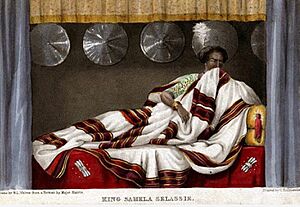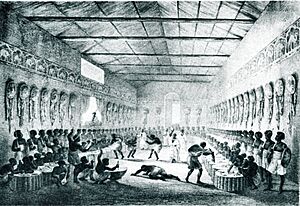Sahle Selassie facts for kids
Quick facts for kids Sahle Selassieሣህለ ሥላሴ |
|
|---|---|
| Merid Azmach | |
 |
|
| Negus of Shewa | |
| Reign | 12 June 1813 – 22 October 1847 |
| Predecessor | Ras Wossen Seged |
| Successor | Haile Melekot |
| Born | 1795 Ankober, Ethiopian Empire |
| Died | 22 October 1847 (aged 51–52) Debre Berhan, Ethiopian Empire |
| Issue | Haile Melekot Seyfe Sahle Selassie Darge Tenagnework Sahle Selassie Ayahilush Wossenyelesh Birkinesh Tinfelesh |
| Father | Wossen Seged |
| Mother | Zenebework |
| Religion | Ethiopian Orthodox Tewahedo |
Sahle Selassie (Amharic: ሣህለ ሥላሴ, 1795 – 22 October 1847) was the King of Shewa from 1813 to 1847. He was an important Amhara noble in Ethiopia. He was a younger son of Wossen Seged. Sahle Selassie had many children, including Haile Melekot, Seyfe Sahle Selassie, and Darge Sahle Selassie. He was also the great-grandfather of Haile Selassie, who was the last Emperor of Ethiopia.
Contents
Becoming King of Shewa
When Sahle Selassie's father was killed, his older brother Bakure could not quickly reach the capital city of Qundi. This was because Oromo rebels were in the way. Sahle Selassie was still a teenager, but he saw his chance to rule. He quickly left the monastery where he was studying. With help from his mother's family, he was declared the leader of Shewa. His brother Bakure arrived later and was put in prison.
Expanding Shewa's Borders
Once Sahle Selassie was in charge, he focused on the rebels. He used clever talks to get the Abichu Oromo people on his side. They needed his help against their neighbors, the Tulama Oromo. He defeated the Tulama Oromo in the early 1820s. After this victory, he rebuilt Debre Berhan, which had been burned. He also rebuilt other towns and made his rule stronger. He did this by building many fortified villages, like Angolalla. He expanded Shewa's land into Bulga and Karayu. He also expanded to the southeast into Arsi, and south to the lands of the Gurage.
Sahle Selassie also continued a policy from his ancestor, Amha Iyasus. He kept a safe area to his north. This area was made up of lands from the Yejju and Wollo Oromo rulers. This helped keep Shewa safe from northern lords like Ras Ali II of Yejju. These lords were busy with their own wars.
Proclaiming Himself King
After a few years, Sahle Selassie felt strong enough to declare himself Negus, or king. He became king of Shewa, Ifat, and the Oromo and Gurage peoples. He did this without the permission of the Emperor of Ethiopia in Gondar. The Emperor seemed to agree with this.
Challenges During His Rule
Shewa faced many difficulties during Sahle Selassie's reign. In 1829, there was a famine. Then, for two years starting in 1830, a cholera sickness spread. Two-thirds of the sick people at Sahle Selassie's palace died.
Rebellions and Natural Disasters
One of Sahle Selassie's generals, Medoko, rebelled. He convinced many skilled Shewan soldiers to join him and the Oromos. Together, they threatened Shewa and burned Angolalla. Sahle Selassie stopped this rebellion around 1834 or 1835. Around the same time, a drought hit Shewa for two years. Most farm animals died, and his people faced famine. Another cholera outbreak happened in 1834. Sahle Selassie helped his people by opening the royal food storage to those in need. This made his people love him even more.
Church Disputes
The Ethiopian Church was divided by arguments over beliefs about Jesus. Shewa followed a belief called Sost Lidet. This was different from the Wold Qib belief in the north. Sahle Selassie tried to gain more control over the Shewan church. He appointed people loyal to him to manage local monasteries. This angered the monks and the head of the Debre Libanos monastery, who was a very powerful church leader. Sahle Selassie faced being removed from the church. So, he removed his appointees on November 24, 1841.
However, supporters of the Wold Qib belief in Shewa then attacked him. When a new church leader, Salama III, arrived, the resistance grew. The new Abuna removed Sahle Selassie from the church in 1845. Even with help from the Imperial Regent, Ras Ali II, the Abuna refused to change his mind. Ras Ali finally arrested the Abuna in 1846.
By this time, Sahle Selassie's health was getting worse. He could not try to become Emperor. His close friends convinced him not to give up his throne to his son. The last years of his rule were quiet.
Achievements as Ruler

Even with all the challenges, King Sahle Selassie was a good and fair ruler. A British visitor, Dr Charles Johnston, praised him. He said Sahle Selassie was known for his fairness and honesty. He was feared by other rulers but loved by his own people.
Helping His People
Sahle Selassie cared about his people's well-being.
- During famines, he opened the royal food storage for everyone.
- When a sickness killed most farm animals, he gave out oxen and mules.
- He kept large amounts of salt. This ensured his people had salt even if trade routes were blocked.
Legal and Administrative Reforms
Sahle Selassie also improved the laws of his kingdom. Before him, courts used old laws that were very harsh. Punishments often included death or losing body parts. King Sahle Selassie changed this. He limited death sentences to only very serious crimes like treason or murder. Even then, he had to approve them. He often changed death sentences to life in prison or taking away property. If someone was convicted of murder, the victim's family could traditionally punish the killer. Sahle Selassie worked to convince families to accept money instead of killing the person.
His changes also included how the government was run. He created a new tax system that was fairer. It also brought in more money for the kingdom. Around 1840, his income was very high. Shewa was like an early example of a welfare state, where the government helps its people.
Modernizing Shewa

Sahle Selassie also wanted to make his country more modern. Like other rulers of his time, he contacted European countries like France and Great Britain. He hoped to get skilled workers, teachers, and especially firearms. He understood how important firearms were. He increased the number of firearms in his storage from a few to 500 by 1840. By 1842, he had doubled that number.
He signed friendship agreements with both France (November 16, 1841) and Great Britain (June 7, 1841). The King also encouraged foreigners to live in Shewa. He offered them good reasons to stay, like giving a Greek builder a large village's income. Because of this, many foreigners lived in Shewa, including Greeks, an Armenian, and traders.
However, Sahle Selassie did not want foreign missionaries. Even though two Protestant missionaries arrived in 1837, they were kindly asked to leave in 1842.



